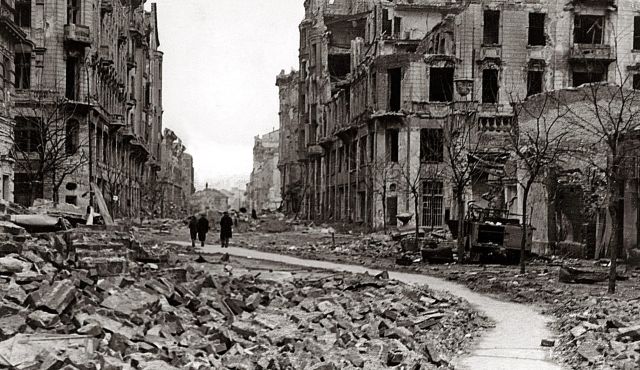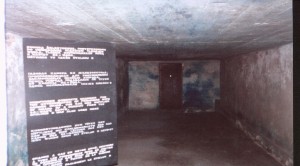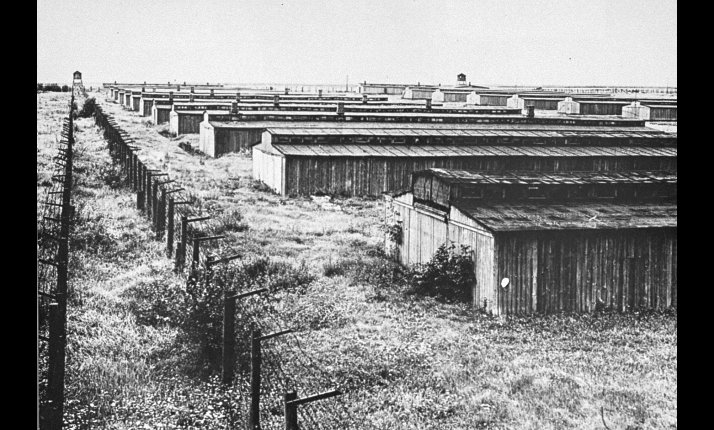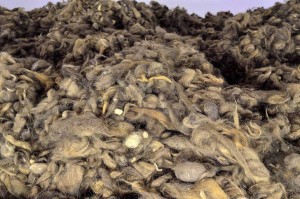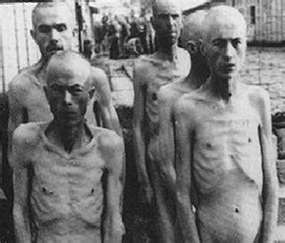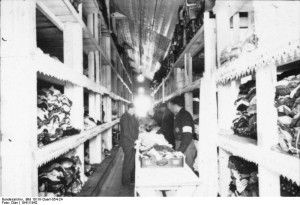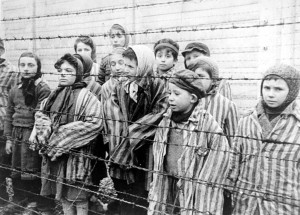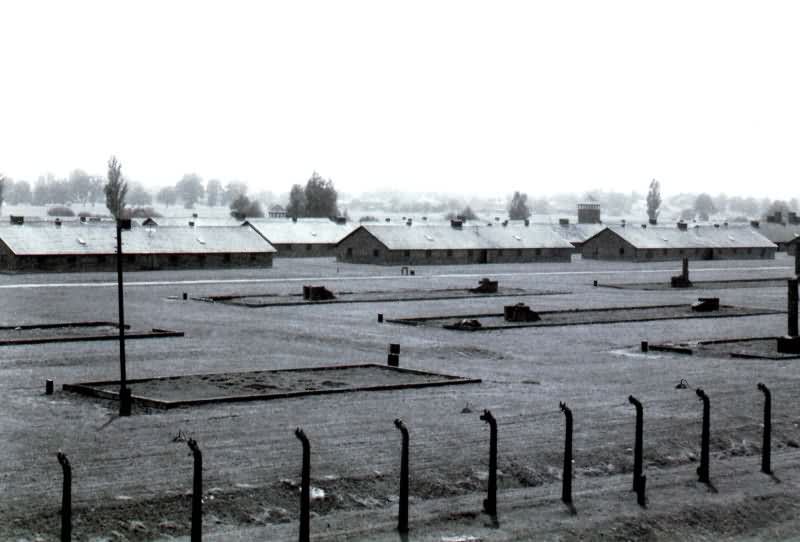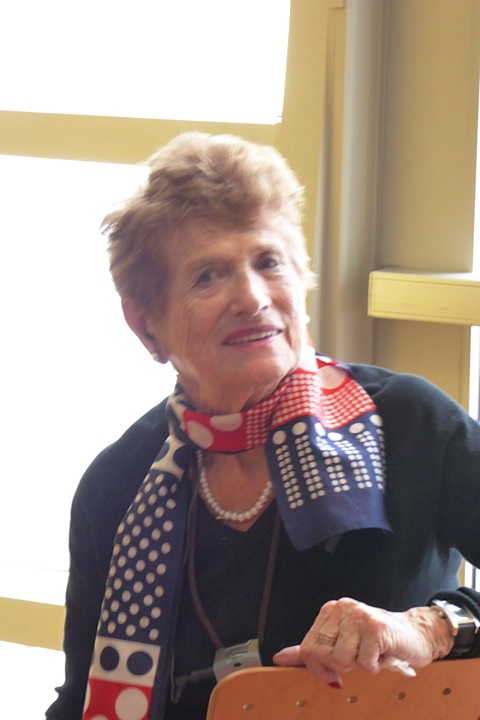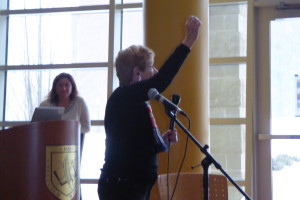"In despair, I try to suppress the tears welling up within me. Panic and fear possess me completely. The curfew hour is drawing near, in a few minutes I will be forbidden to be seen on the street. People are deeply troubled and scattered in all directions. The street is deserted. My spirit is completely broken." - Ruchama Rachel Rothstein, author of Here There is No Why, Holocaust survivor
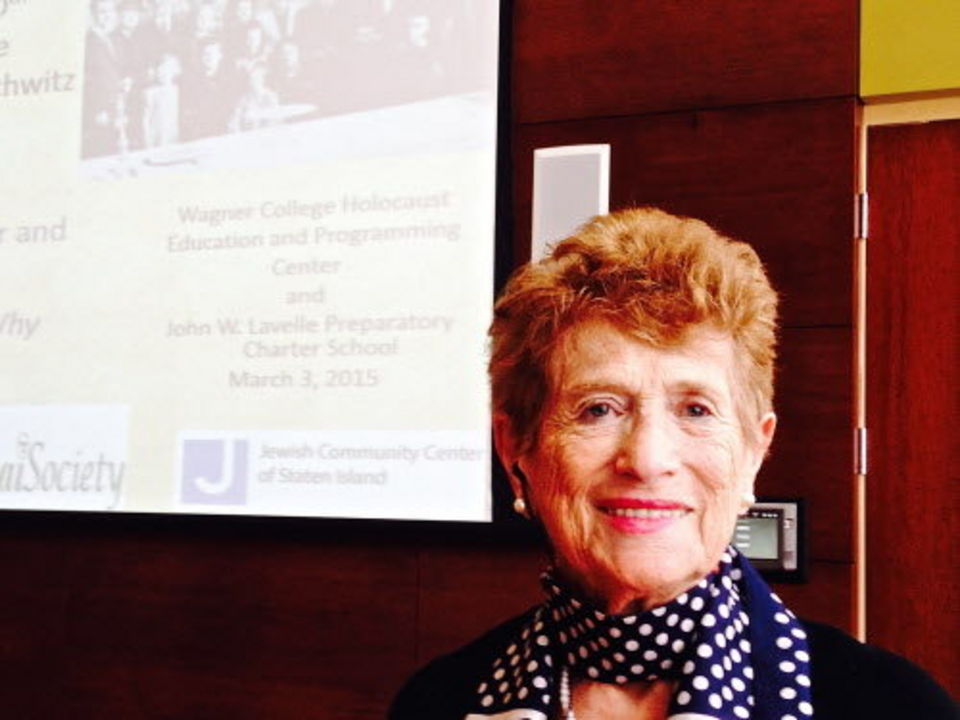
On March 3, 2015 Rachel Roth spoke about her experiences during the Holocaust at Wagner College on Staten Island. Copyright Staten Island Advance.
Rachel Roth experienced first-hand the persecution of the Jews of Poland. On October 16, 1940, one month after the Nazis invaded Poland, the city of Warsaw was divided into three zones. One of these zones was made into the ghetto and all Jewish citizens were forced to live in it, including Rachel and her family. Life in the ghetto for Rachel and others was harsh, there were diseases and starvation that caused many to die. While in the ghetto, Rachel lost many of her family members including her mother. Rachel Roth participated in the Warsaw Ghetto Uprising by smuggling weapons throughout the ghetto. After the uprising, the Nazis “resettle” the Jews that live in the ghetto. Rachel, her aunt Hela, and her grandfather are sent on a train to Majdanek where they are forced to work in horrible conditions. After weeks of working in the camp, Rachel and Hela are transferred to Auschwitz-Birkenau where they stay for two years. At times, Rachel wants to give up on life, but she persevered and struggled to make sure that she made it out of Auschwitz. Towards the end of the war, the prisoners of Auschwitz-Birkenau were transferred to Bergen-Belsen where they stayed until the British liberated them in April 1945. Rachel’s story is one of hardship and survival, and throughout all the pain she suffered, she managed to be hopeful that one day she would be saved. After being liberated, Rachel Roth later married, had five children, and is now watching her grandchildren grow. Rachel Roth currently resides in New York, New York where she visits many schools to share her Holocaust experiences and stories. Rachel's message is to remember and to never let something like the Holocaust happen again.
The Early Years
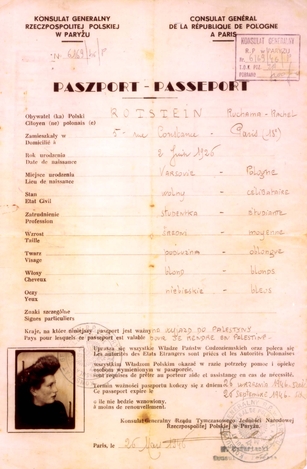
Rachel's Polish passport from 1946. Copyright Yad Vashem The Holocaust Martyrs' and Heroes' Remembrance Authority. The Early Years
Rachel Roth was born in Warsaw, Poland in 1926. She was welcomed into the world by proud parents, Golda and Samuel Rothstein. Her family also included three other daughters; Justinka, Reginka, and Davidik. Her family was highly religious and practiced the Jewish faith. Rachel lived a life of freedom, innocence, and beauty. She was constantly laughing and playing with her family and friends. Some of her favorite pastimes were reading, exploring, and visiting the beach. After the rise of the Nazi Regime, life began to change for Rachel. Rachel was only thirteen when the Nazi's invaded Poland. Upon invasion of Warsaw, Rachel's hometown, the Nazi's brutally defeated the Warsaw Army and captured the capital city of Poland. The Nazi's had an unjust hatred toward the Jews. After conquering Poland, Nazi leaders began a plan of segregation and eventually extermination of the entire Jewish race. Nazi's were extremely prejudice against Jews and used violent tactics against them. These cruelties allowed the Nazis to take away Rachel's freedoms and humanity.
Warsaw Ghetto
In 1940, the first stages of Nazi segregation were beginning to unfold. Rachel, along with her entire family, were forced to relocate to a specially segregated area of Warsaw, known as the Warsaw Ghetto. This ghetto area was created in order to concentrate the Jews into one centralized location of the city, in hopes of regulating and controlling their everyday lives. Life in the ghetto was certainly not easy. "Life in the Ghetto was hard. People were sent from all over, but we tried to live a normal life." There were often bursts of violence, which resulted in death or serious injury. Many families, like Rachel's, were living in poverty with barely the necessary essentials to get by.
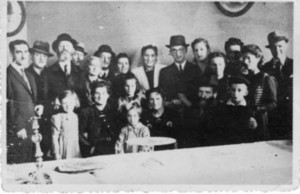
Family photo that was taken at a wedding in the Warsaw Ghetto in Rabbi Mendelson's apartment. Copyright Here There Is No Why.
Since food was scarce, many fell victim to mass starvation. The risk of starvation forced children, even younger than Rachel, to grow up quickly and take responsibility to become breadwinners for the family. Carefree childhoods were rapidly replaced by the need to scavenger around for food to provide for their families. Children went to great lengths to acquire just enough food to resist starvation, some children even had to sneak food through a hole in a wall. Residents of the Warsaw Ghetto, lived alongside Rachel in overcrowded and disease ridden living quarters. These extremely unsanitary and close living conditions resulted in painful diseases and in some cases even death.
"Further crowding has resulted in conditions of ill-health, hunger and monstrous poverty that defy description. Groups of pale and emaciated people wander aimlessly through the overcrowded streets. Beggars sit and lie along the walls and the sight of people collapsing from starvation is common. The refuge for abandoned children takes in a dozen infants every day; every day a few more people die in the street. Contagious diseases are spreading, particularly tuberculosis".
At one point, a Typhoid breakout threatened Rachel's brother's life, while sadly claiming the life of her grandfather.
The formation of a school and education in general were strictly forbidden in the ghetto. However, this certainly did not stop young Jews, including Rachel, from having a strong thirst for education. To quench their thrust for a rewarding education and just to have something to look forward to everyday, a secret school was established within the ghetto. Rachel was one of the dedicated pupils who attend the school religiously each day. Her teacher, a dedicated and daring woman, held private classes for a group of eager children. One of the many subjects Rachel studied while in the Ghetto was Chemistry. Rachel developed a deep love for chemistry while in the ghetto, really enjoying working with chemicals in a lab like setting. Unfortunately, Rachel was not able to complete her education prior to the beginning of deportations to the death camps.
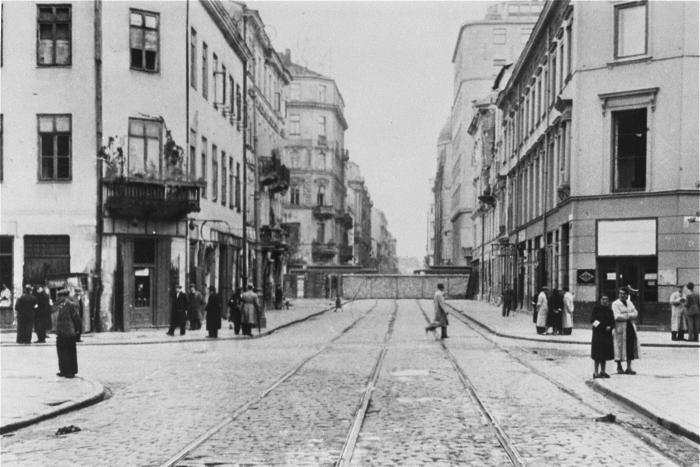
Street scene in the Warsaw ghetto showing a section of the wall blocking a major thoroughfare. Copyright United States Holocaust Memorial Museum.
Warsaw Ghetto Uprising
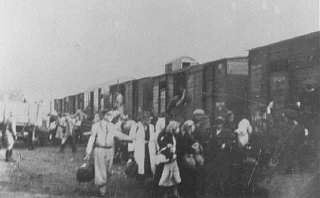
Deportation of Jews from the Warsaw ghetto. Warsaw, Poland, 1943. Copyright United States Holocaust Museum
As conditions began to deteriorate in the ghetto, the Jews became the targets for deportation to concentration camps. Nazi's would pass through the ghetto in violent raids, ripping families from their homes and leading them to trains that would deport them to the inevitable death camps. Families throughout the ghetto lived everyday in fear. Rachel's family even tried to hide in a secret bunker they created. They had hoped they could live out the raids hidden and once it was over they would still have each other and their lives. However, things did not work out as planned. As the need for basic necessities required members of Rachel's family to leave the bunker and interact in the ghetto, some were not fortunate to return. "People would go out onto the streets and they never came back." Among them would be her mother, two sisters and a brother. The majority of Rachel's family was captured and sent to concentration camps. However, Rachel remained until the infamous Warsaw Ghetto Uprising, in which she was an avid participant. She even went to great lengths to smuggle weapons into the ghetto to help Jewish resistors in the uprising.
Preparing for Warsaw Ghetto Uprising
On the eve of the uprising, Rachel can recall observing Passover. However, as the Nazi's began a raid, Rachel's celebration was cut short by her need to escape from her beloved bunker. The Nazi's had discovered the hidden bunker ideas amongst ghetto residents and decide to not only raid the ghetto, but burn down the bunkers, forcing hideaways out and into the open streets. The day following this night of fire and rage, turned into a brutal uprising amongst Jewish resistance members and Nazi officials. The resistance believed they could battle the Nazis and end the deportations to the camps. Although they were successful at prolonging the deportations, they could not stop the inevitable. Rachel along with her aunt Hela, were now on their way to their own destiny in the concentration camps.
Majdanek
Following the Warsaw Ghetto Uprising, a planned attack on Nazi officials by the Jewish resistance, any Jews remaining in the ghetto were deported to Majdanek. Among these deportees was Rachel Roth:
“ I hold onto Grandpa’s hand tightly, while Hela grabs my other hand, afraid that in the confusion we will be separated. Pushed, brutally, kicked and pummeled, we stand at attention in rows. With our hands up, we move in the direction of the waiting wagons. The threatening eyes of rifles glare at us persistently, while the cattle cars devour the human cargo.”

Jews being transported in cattle cars from the Warsaw Ghetto to Majdanek, one of the Nazi concentration camps. Copyright Holocaust Education & Archive Research Team.
The thought of being separated from your family at such a chaotic time filled many with fear and sorrow. Jews rounded up in the Warsaw ghetto were forced into overcrowded cattle cars fearful of what lay ahead.
“The train moves forward slowly with a rhythmic clatter, a monotonous click-clack. With a sudden surge of energy, the train picks up speed, causing the mass of standing humanity in the car to tip over, falling on top of each other. Some faint from the heat and crowding."
Rachel and her aunt Hela were first transported to Majdanek, a concentration camp in Lublin, Poland. Upon entering the camp, Rachel was stripped of her pride and individuality. The vast majority of Jews that arrived in Majdanek were used as forced laborers and either died as a result of inhumane living conditions or were killed in the gas chambers after the Germans determined that they could no longer work. Many were killed in shooting operations, while others died of disease, starvation, exposure and overwork.
While imprisoned in Majdanek, Rachel always told stories to the other women in her barrack. Rachel used the art of storytelling as a way to distract the women from their hunger and the many horrors they witnessed throughout the day. Rachel would tell the women stories of the wonderful Jewish meals she once had in her house.“Attractively decorated with slices of carrot, the gefilte fish served in a sweet sauce is excellent. The wonderful aroma of a roast wafts in from the kitchen. The long white noodles swim in the yellow broth.” Through the use of figurative language Rachel was able to activate the other prisoners senses of taste, smell, and sight, which served as a distraction for them.
Due to her strength and youthfulness that extended beyond her sleepless, fragile, and frail body, an unknown person confided in Rachel:
“ I won’t live to see freedom. I’m condemned to death. But you’re young. You have to survive. Do you understand? Promise me that you will survive and free yourself from this inferno and that you will tell the whole world what the beast did to us here.”
This older woman confided in Rachel because she believed she had the will and the power to survive. Through the use of storytelling Rachel painted a vivid picture of Jewish traditions in the woman’s mind, making the last minutes of the woman’s life pleasant instead of in suffering. Seeing this woman with a sad and tired look in her eyes, Rachel agreed to live out this promise. “At that moment, I declare war against death.” Rachel promised that she would survive, leave the camp, and tell the stories of all the people who did not make it out alive.
On the eve of her transfer to Auschwitz, Rachel, along with a group of other woman, were squeezed
into a gas chamber, where they are told they will spend the night, awaiting deportation to another camp in the morning. Rachel would later find out that there has been an error. By a saving grace, during the head count before Rachel’s group entered the gas chamber, the German official had found the count to be wrong. “He had received an order to gas five hundred Jewish women, not seven hundred. The other transport to the next concentration camp was accidentally switched with the transport to be gassed.” This last minute accounting error saved Rachel death by the infamous gas chambers, giving her a second chance at life. “Sometimes a fraction of a second may seem completely insignificant in a human life, but here it was the difference between life and death.” Although Rachel's life was saved due to a mere mistake, her grandfather was not as lucky and fell victim to the "final solution" when the male and female prisoners were separated.
Auschwitz-Birkenau
Prisoners sent to Auschwitz, like Rachel, arrived in overcrowded cattle cars that pulled directly into the camp. Upon entering the camp, all prisoners were greeted by the large, infamous gates.
“We jump out of the open cars and stretch our limbs. They line us up in rows of five and march usto a gate topped with a sign that reads “Arbeit Macht Frei”- Work Makes You Free. We march through the gate into Dante’s Inferno, which now goes by the name Kinzentrationslager Auschwitz-Birkenau, Birkenau for short.”
Processing and Routines
Labor became another form of genocide that the Nazis called "extermination through work." Victims who were spared immediate death by being selected for labor were systematically stripped of their individual identities and dehumanized. Like Rachel, prisoners underwent brutal treatments, which was considering part of the registration process for entering the camp. All prisoners were forced to have their hair shaved off.
“Then we’re taken to another barrack, where the barbers are waiting for us. Pushed forward abruptly by the crush of people behind, I find myself in front of the barber. He grabs me by the hair and goes to work with the large tailor’s scissors. My brown locks float silently to the floor. They mix with black, red, and blonde hair and are stuffed into large sacks by other prisoners. Instinctively, I grab my shorn head. Under my fingers, I feel the sharp ridges of clumps of hair that the dull scissors left uncut.
Cutting off a prisoners hair, for many a personal feature of the body, was one way in which Nazi officials dehumanized the Jews and other prisoners of Auschwitz. By stripping them of a physical feature, such as ones hair, the Nazis had hoped to take away the feeling of being a human being and create a feeling of worthlessness in the prisoners. Prisoners were they given a “hygienic” bath, in which cold water came streaming down upon them from the shower heads. Although the water was cold, Rachel took this as an opportunity to quench her burning thirst and desire for a drink. However, fearful that they might be giving the prisoners too much satisfaction; camp officials switched the hot water on rather quickly.

Rachel showing her number 48915, which was branded on her upon entering Auschwitz. Copyright Sara Signorelli.
After the “hygienic” baths, prisoners were chased into yet another barrack, where they would stand shivering in the cold, waiting to be given new clothes. Men were forced to wear ragged, striped pants and jackets, and women wore work dresses. Both were issued ill-fitting work shoes, sometimes clogs. They had no change of clothing and slept in the same clothes they worked in. At this point friends and family members, like Rachel and Hela, were separated into different areas depending on the first letter of their last name. As a way to put the current prisoners in Auschwitz to work, they were responsible for registering the new incoming prisoners, as well as branding their arms with a number.
“A prisoner in a blue and white striped dress sits behind a table recording the information, writing down my first name, last name, and place of birth. At the next table, another girl waits for me holding something resembling a syringe. She makes some punctures on my left arm and injects a few drops of ink into the bleeding spots. She tattoos my prison number, 48915, and a small triangle, half a Star of David, below the number, to show that I am a Jew.”
"I lost my individuality. Rachel Rothstein exists no longer. A nameless prisoner was born, prisoner number 48915."Branding prisoners, each with a unique number was not only a way to keep track of how many prisoners would enter Auschwitz, but also to strip them of their identity and livelihood,
furthering the process of dehumanization by making them just a number with no identity. No longer would they be identified by their names or the cities they used to call home. All of the prisoners were condemned to a number, which would become their sole source of identity while in the camp.
Living Conditions
Prisoners were housed in primitive barracks that had no windows and were not insulated from the heat or cold. There was no bathroom, only a bucket. Each barrack held about 36 wooden bunk beds, and inmates were squeezed in five or six across on the wooden plank. These barracks, 36.25 meters long by 11.40 meters wide and 5.80 meters high had seventeen permanently closed windows, two ventilators and one door on either side of which were two rooms, one for the Block Elder, the other for storing bread. Initially these huts did not have electric light either. Surprisingly, as many as 500 inmates were forced to sleep in one single barrack, similar to that of what Rachel called home during her time in Auschwitz.
“ They lead us to a large brick barrack, almost pitch dark inside. The unpleasant stench of mildew rises from the cement floor. There is a labyrinth of long, dark passages. Along both sides are cement bunks divided by a low wall of bricks. They crowd ten girls into each cubbyhole, then distribute black blankets with a suspicious smell and look. The dim lights are turned off. The space we are crammed into is so tight that we have to sleep practically one on top of the other.”
Identification/ Labor Force
In Auschwitz, as well in the entire Nazi concentration camp system, there were various categories of prisoners. The category a prisoner belonged to could be identified by the color of the triangle on his or her camp uniform. “Prisoners sport different colored triangles. A red triangle indicates a political prisoner, green a criminal, and a black triangle stands for an asocial or a German prisoners convicted of a crime. Jehovah’s Witness are distinguished by a purple triangle.” A yellow star

Various badges used to distinguish the different categories of prisoners in Auschwitz. Copyright Arnold Liebster Foundation.
designated a Jew.
In Auschwitz, some prisoners worked as forced laborers inside the camp. “They line us up in working kommandos. Hela and I are assigned to Kommando #103, with the task of breaking stones.” Other prisoners were able to secure easier and less strenuous jobs than others, which made other inmates like Rachel quite envious. “I envy the lucky women who manage to get the job of grinding stones, which is easier than carrying them from one spot to another." The workday would come to an end with a signal from SS officials, marking the end of the brutally overly strenuous day. “On the distant horizon, the sun sinks lower and lower. A redeeming whistle rents the air, informing us that our day of slave labor has come to an end.”
As the workday came to an end, prisoners could barely drag their exhausted and hunger-ridden bodies back to the camp. Hunger was pervasive. It tormented prisoners both before and after meals. Even the thought of hunger tormented prisoners in their sleep. Prisoners had countless conversations about hunger and ways to appease it. Food was the main thought on almost every prisoners mind, although not everyone went equally as hunger as others. Food consisted of watery soup made with rotten vegetables and meat, a few ounces of bread, a bit of margarine, tea, or a bitter drink resembling coffee. Each prisoner was allotted a daily ration of 350 grams of bread, half a liter of coffee for breakfast, and one liter of potato and turnip soup for lunch. Four times a week each prisoner was allowed a food ration of 20 grams of meat in their soup. The daily value of food for prisoners employed in light work stood at 1,700 calories and for prisoners doing strenuous work, 2,150 calories.
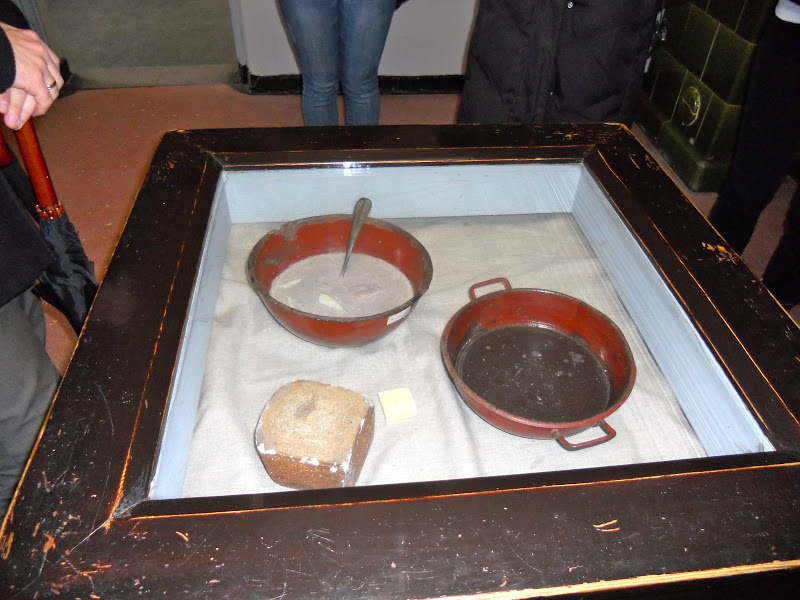
Food rations allotted to each prisoner in Auschwitz. Copyright Global Crossroads.1,700 calories and for prisoners doing strenuous work, 2,150 calories.
“My companions in misery and I get our three quarters of a cup of watery turnip soup in a rusty iron bowl. That, along with a loaf of black, gluey bread, is supposed to fill eight empty stomachs. One of the girls in our group holds the bread in her hands reverently, while the rest of the girls watch her carefully divide into equal pieces with a piece of string.”
At times, thirst was even more physically and mentally debilitating than hunger. The water at Auschwitz was contaminated with various impurities, and even members of the SS were instructed not to drink it. This warning was not extended to the prisoners. Many prisoners, especially the women, suffered from the chronic shortage and poor quality of water in Auschwitz.
Disease
People were weakened by dehydration and hunger, which allowed them to easy fall victim to the contagious
diseases that spread through the camp. Diarrhea was common amongst the prisoners. At one point an epidemic of scabies broke out across the camp. With the outbreak spreading fast, German authorities had to develop a way to extinguish the disease and those that were infested with it, before it became an even bigger outbreak. The German authorities declared a war on scabies, eager to eradicate it’s victims by gassing them. German doctors in the camps began to examine each prisoner for the contagious sores that inhabited a scabies victim’s body. Jews and other prisoners alike developed a constant fear of the daily selection of scabies. This scabies epidemic broke out in Auschwitz during the time that Rachel was a prisoner of the camp. When a prisoner was affected with scabies, sores appeared on the skin and itched terribly. Prisoners couldn’t scratch because that would only help the sores to spread quickly all over the body. A single scratch was lethal. Rachel recalls an all too horrific experience of living in fear of not knowing what would happen during the daily selection of scabies by camp doctors. The German authorities declare war on scabies by exterminating those who are infected. The simple German solution is to gas the sick prisoners. We now live in constant fear of the daily selections for scabies.
While Rachel was not subjected to selections while working in the bekleidungskammer, an unexpected abscess under her arm completely turns her renewed life in the camp upside down.
“To my consternation, an abscess appears under my arm completely unexpectedly. The weeping sore blooms and grows and puffs up painfully under my arm. With growing terror, I listen to the light step of Schmidt coming closer. She stops at my table and stabs me with her hateful look. I stare at the table and try to work quickly and honestly even though I’m in great pain from the undesired abscess. I clench my teeth to keep from moaning in pain. Schmidt says: Don’t you dare come to work any more. I don’t want to see your face again, you Muselman.”
A Muselman was a condemned prisoner of the Nazi death camps that was deemed unfit to work. Since a Muselman could not work, prisoners that were labeled as a Muselman were often sent to be executed and burned in the Auschwitz crematorium. Rachel was fortunate that even though she had an abscess under her arm she was still able to survive Auschwitz without being sent to the infamous crematorium.
Tracking Time and The Seasons
As a pastime and a way to keep some type of record of life in Auschwitz may Jews resorted to tracking time in the camp. Many prisoners were resourceful and eager to find any way to create and maintain some type of a calendar. It also served as the only human part of life they had left. Keeping track of time was a way of keeping ones sanity, dignity, and sense of connectedness to the world. Various sorts of calendars were carved or sketched on prison block walls. Some prisoners drew days, weeks, months, and years, while others simply used columns of dots or slashes. As the Nazis tried to strip the Jews and prisoners of everything, including their identities, they used this as a way of coping with the horror around them. It gave them a reason to live. For Rachel, she paid careful attention to the various seasons during her time in Auschwitz. She used the changing seasons to remember significant events and conditions within the camp. She also uses it to document weather and to show a change in conditions across the many different seasons. She recalls conditions during her first fall season in Auschwitz:
“The fall is a wet one, with constant drenching rain. The camp becomes one huge mud puddle. As we return to the camp after a full had of hard labor, the skies are completely overcast by heavy clouds, and soon a torrential rain starts pouring out of them. Flashes of lightening, accompanied by the roar of thunder, break the darkness. The silhouettes of soaked bodies are outlined against the lightening. Drenched to the skin, I have great difficulty trying to march to the music of the band, since my wooden clogs keep sinking in the thick mud.”
Rachel also recalls a rather brutal winter of 1944 in Auschwitz. The winter was an extremely hard one where prisoners were subjected to hunger, cold, merciless selections, and waves of epidemics brought on by the terrible conditions. Rachel recalls:
“The torrential rains of autumn turn into driving snow. As a child I used to greet the snow as an old friend, but now the benign countenance of the snow is changed into the sneering visage of an intractable enemy. Angrily, he blows icy dust into our eyes, chills our emaciated bodies, insinuates his freezing flakes under our clothes, and clings to our wooden clogs, thus making walking more difficult.”
Rachel recalls one frosty morning, being called by her number, 48915, and thinking this was the end. Her life would shortly end. However, blockowa brought her to a barrack inhabited by the chosen ones who work in the bekleidungskammer, the clothing warehouse. Being called out, certainly was the end, but was just the beginning of a better life beginning to dawn. Rachel was on her way from becoming just a number to a strong survivor.
“The bekleidungskammer is the second-best assignment in the camp, and also the most profitable, after Kanada. The girls who work there are part of the camp elite. The wives, sisters, and friends of the sonderkommando are employed there. The sonderkommando is made up of men whose job it is to remove the dead bodies after they have been gassed. They are assigned to feed the gassed corpses into the crematorium ovens.”
The bekleidungskammer was a group of women, like Rachel, whose job was to sort through the piles of shoes, clothes, and other belongings that had been confiscated from the prisoners upon arrival at the camp. Rachel’s job was to sort women’s underwear quickly and make bundles. The clothing was sorted in piles of what was of value and what was not. The good items that were believed to have some type of value were shipped to Germany for use there.
“The workers in the bekleidungskammer belong to the group called protektzion, protected children. During the winter, they are excused from standing outside for long hours in the frost and snow at the morning and evening appel. They work inside a building, and they are not subjected to the selections. They are clean and healthy and do not look as if they suffer from hunger. They have free use of the washroom, where they bathe in warm water almost every evening. The work is not difficult. The main job, which is carried on inside consists of sorting the clothing of newly arrived Jews from all over Europe, most of them who have been murdered in the gas chambers of Auschwitz-Birkenau.”
Nearing the End
As time moves along, for the prisoners extremely slowly, it is not until the end of summer 1944, that transports arrive with less frequency, signaling a closer grasp of freedom and survival. Rachel recalls this time:
“Summer 1944 is easing into the fall. Transports arrive with less frequency. Selections cease, and the ovens are shut down. The consuming flames had been roaring from the chimneys only days ago. An ill wind blows in the stench of melting fat and burning hair. Rumors pass around in hushed tones about a devastating German defeat on the Russian front and a massive offensive by the Allies. People are being to feel more at ease. The men in the sonderkommando, it is said, are dismantling the ovens in the crematorium. Our hopes for a better tomorrow start soaring.”
The summer of 1944 became a turning point in the war as well as in Hitler’s “final solution”. With the hopes of freedom so close, prisoners begin to plan a resistance movement within the camp. Since the world around them was unfeeling and remained deaf to their calls for help, they decided they needed their own movement to move them to freedom and liberation. For far too long prisoners in Auschwitz witnessed columns of thick smoke and red tongues of fire pouring put of the crematorium chimneys. As Rachel recalls:
“Apparently, those chimneys are not important enough to divert some bombers a few miles from their designated targets. It is not feasible militarily. Now, however, it is indeed possible for them to mount their own resistance. Following the merciless, treacherous murder of two hundred sonderkommandos, the Auschwitz-Birkenau underground decides to go into action, taking the initiative into their own hands, and they attempt to demolish the accursed death machine on their own.
The Final Camp: Bergen-Belsen
“One gray November morning in 1944, they load us into a train full of cement dust. Once again, we make a long, cold trip to the unknown in sealed cattle cars without food. We can’t judge how much time has passed when we hear the whistle of the locomotive and feel the rapid application of the brakes tugging at the cars.”
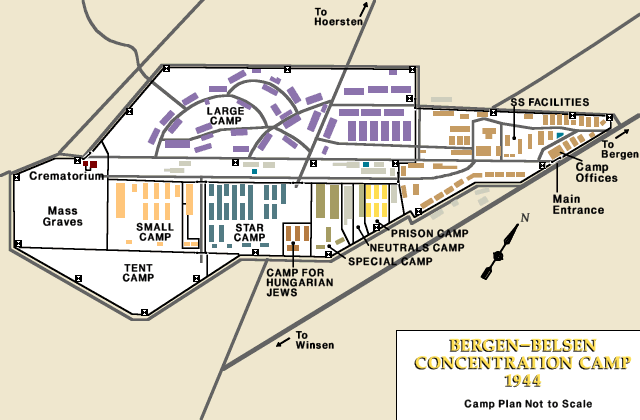
Map of Bergen-Belsen, the concentration camp Rachel was liberated from. Copyright United States Holocaust Memorial Museum.
Rachel and her Aunt Hela spent the last few years of the Holocaust imprisoned in Bergen-Belsen, the same camp as Anne Frank. They were liberated on April 15th, 1945 by the British Army. Rachel remembers the liberation day very fondly.
"When English troops came and liberated the prisoners of Bergen-Belsen, people were shouting "Long live England! Long live the King! Long live everybody!' We were kissing their tank. The tank couldn't go. It was the nicest moment of my life. I was never so happy in my life."
Rachel recalls that many prisoners were kissing the British tanks as they rolled through and many in the British army had tears in their eyes because of what they saw. After being liberated, Rachel traveled to France to meet with her father’s friend who was able to send Rachel to Palestine to meet with her father. It was in Palestine where Rachel meets her future husband Shlomo, who was also affected by the Holocaust. Rachel and Shlomo were married in November of 1947.
The Present: Rachel Roth Now
Rachel Roth, 89, was a longtime resident of Todt Hill, a community in Staten Island, New York. She is the mother of five children and the proud grandmother to 18 grandchildren and 17 great-grandchildren. Rachel was one of the many Holocaust survivors who agreed to have her experiences documented by Steven Speilberg as part of the Shoah Foundation's Holocaust survivor interviews. Rachel has spoken at various schools and events, educating younger generations about the atrocities of the Holocaust. "Never again. Never forget. Always remember! Tell your children and grandchildren about the horrible things they did to us. This can never happen again." Rachel continues to uphold her promise she made to the elderly lady while in Majdanek through her various interviews and her autobiography, Here There is No Why. Rachel is extremely grateful for her survival and believes that by educating others, we can prevent an occurrence so horrific and fatal from ever happening again. Rachel’s is still in close contact with her aunt Hela who now resides in South Africa. They visit each other frequently throughout the year. Recently, Rachel spoke at Wagner College in Staten Island, New York. Rachel currently resides in Manhattan, New York.
Pictures and NY1 Coverage from Rachel's talk at Wagner College
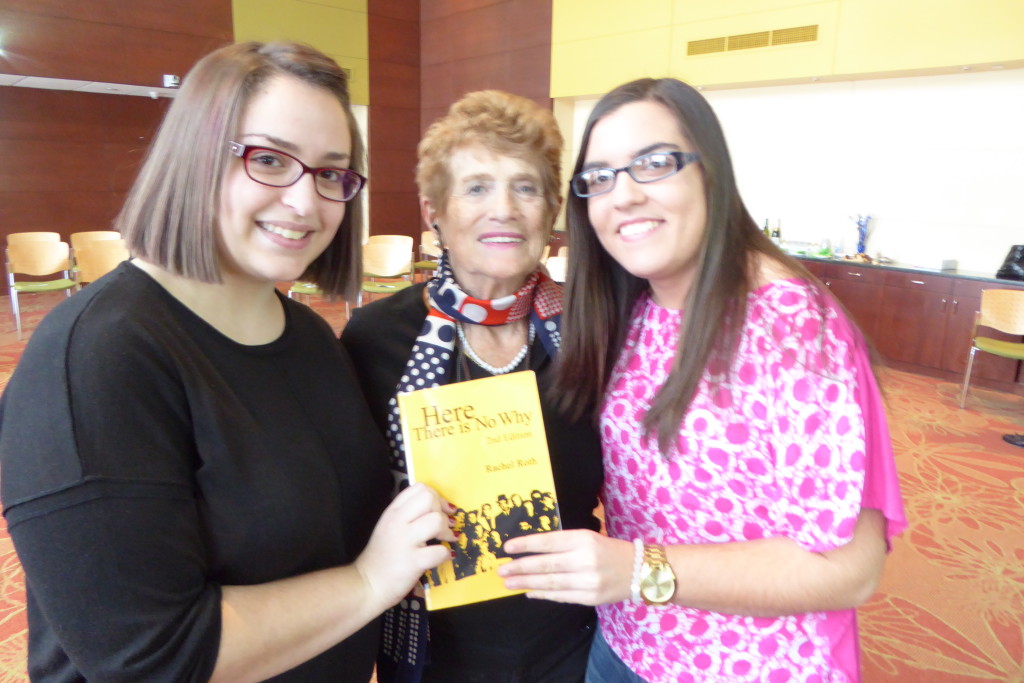
Jessica Catanzaro, Rachel Roth, and Theresa Reed with Rachel's autobiography Here There is No Why.
Copyright Theresa Reed
Authors: Jessica Catanzaro '16 & Theresa Reed '17
Bibliography
Allen, Michael Thad. "Not Just a `Dating Game': Origins of the Holocaust at Auschwitz in the Light of Witness Testimony." German History, 2007, 162-191.
Arens, Moshe. "The Development of the Narrative of the Warsaw Ghetto Uprising." Israel Affairs, 2008, 6-28.
Bauman, Janina. “Seen from the Window; Memories of the Warsaw Ghetto Uprising.” Dialogue & Universalism 13, no. 3/4 (March 2003): 55.
Burleigh, Michael. "Anatomy of the Auschwitz Death Camp." TLS. Times Literary Supplement no. 4796 (1995), 12.
Cole, Tim. "Crematoria, Barracks, Gateway: Survivors' Return Visits to the Memory Landscapes of Auschwitz." History & Memory: Studies in Representations of the Past 25, no. 2 (2013): 102-31.
Friedlander, Saul. Nazi Germany and the Jews 1933-1945. Abridged ed. New York: HarperCollins, 2009.
Gutman, Israel. Resistance: The Warsaw Ghetto Uprising. New York: Mariner, 1994.
Kassow, Samuel D. Who Will Write Our History? : Emanuel Ringelblum, the Warsaw Ghetto, and the Oyneg Shabes Archive. Bloomington, IN, USA: Indiana University Press, 2008.
Marrus, Michael R. “Ghetto Fighter: Yitzhak Zuckerman and the Jewish Underground in Warsaw.” The American Scholar, no. 2 (1995): 277.
Myall, Steve. "Secret diaries of Dr. Mengele, the Angel of Death." The Mirror (London, England), 2011.
Neander, Joachim. "Auschwitz Scholars Examine Auschwitz." Yad Vashem Studies 30, (April 2002): 437-449.
Pelt, Robert Jan van. The Case for Auschwitz: Evidence from the Irving Trial. Bloomington: Indiana University Press, 2002.
Person, Katarzyna. Assimilated Jews in the Warsaw Ghetto, 1940-1943. Modern Jewish History. Syracuse, New York: Syracuse University Press, 2014.
Powell, Lawrence N. Troubled Memory. Chapel Hill, NC, USA: University of North Carolina Press, 2000.
Rees, Laurence. Auschwitz: A New History. New York, NY, USA: Public Affairs, 2006.
Rok, Adam. “Sixtieth Anniversary of the Warsaw Ghetto Uprising.” Dialogue & Universalism 13, no. 3/4 (March 2003): 59.
Rosen, Alan. "Tracking Jewish Time in Auschwitz." Yad Vashem Studies 42, no. 2 (October 2014): 11-46.
Roth, Rachel. Here There is No Why. Translated by Professor David and Roselyn Hirsch. New York: CreateSpace, 2013.
United States Holocaust Memorial Museum. “Introduction to the Holocaust.” Holocaust Encyclopedia. http://www.ushmm.org/wlc/en/article.php?ModuleId=10005143. Accessed on April 10, 2015.
Waxman, Zoe Vania. Writing the Holocaust : Identity, Testimony, Representation. Oxford, GBR: Oxford University Press, UK, 2006.
Zuckerman, Yitzhak, and Barbara Harshav. A Surplus of Memory : Chronicle of the Warsaw Ghetto Uprising. Berkeley: University of California Press, 1993.


